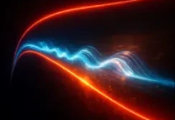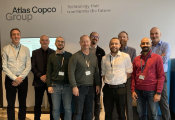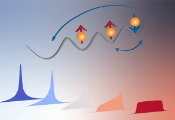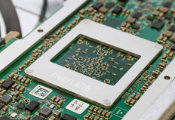Simulating Quantum Systems in Superconducting Circuits
August 14, 2024 -- While truly functional quantum computers are still in development as a future technology, this does not mean that researchers cannot take advantage of quantum properties in the nearer term. One method to do this is through an approach called analog quantum simulation.
“Regular computers cannot simulate quantum systems efficiently, but what we can do instead is engineer quantum systems that we can control in such a way that they mimic the behaviour of the quantum problem we’re trying to understand,” says Dr. Jamal Busnaina, a postdoctoral fellow in the Institute for Quantum Computing (IQC) at the University of Waterloo.
In his research, Busnaina studies superconducting microwave resonators, which can store energy and interact with each other. Using resonators at different frequencies, the interactions can be engineered to be controlled individually, unlike most other platforms. This makes their platform a desirable option for analog quantum simulation.
Together with their collaborators, Busnaina and Dr. Christopher Wilson, a faculty member at IQC and a professor in the Department of Electrical and Computer Engineering, have realized quantum analog simulation of a new type of system. This version of their simulation, known as the bosonic Kitaev model, is made using a class of subatomic particles called bosons which includes photons (particles of light) and the Higgs Boson, which are linked together in a chain.
For the first time in a superconducting system, the researchers simulated unique features of the bosonic Kitaev model resulting from the structure of the equations describing their dynamics, known as non-Hermitian features.
To prove that they simulated this non-Hermitian system, the researchers identified several unique features. First is chiral transport, which means that different particles in the system move in opposite directions. The second feature observed, known as the non-Hermitian skin effect, is a change near the edges of the material that creates localized regions near the boundaries of the model. The presence of both of these features is the basis for their conclusions.
For this experimental work, the team fabricated superconducting devices in a cleanroom environment, at the Quantum-Nano Fabrication and Characterization Facility (QNFCF) at Waterloo, then added a device called a SQUID to create interactions between the resonators. Their experimental device was used to simulate quantum systems which closely matched the expected theoretical models.
“Non-Hermitian systems have applications including directional quantum amplifiers and quantum sensing,” says Busnaina. “Studying open quantum systems experimentally is currently very hard. Often, the open systems experience quantum jumps which randomly scramble the system, so those results are trashed. In our system, we don’t have to worry about that.”
Universal quantum computing devices, which spearheaded the ideas of digital computation and quantum gates, are still ahead of us, but advances like this work will allow researchers to use quantum simulation to mimic and study different problems within quantum information in the nearer term.
"Analog simulation played an important role in the history of computing, playing an integral part in the development of industries such as aerospace and industrial chemistry before universal digital computers became ubiquitous. We hope that analog quantum simulation can play a similarly important role while we wait for universal quantum computers." Sadi Dr. Christopher Wilson.
The study Quantum simulation of the bosonic Kitaev chain was recently published in the journal Nature Communications by Busnaina, Wilson, Dr. Zheng Shi, Dr. Dmytro Dubyna, Dr. Ibrahim Nsanzineza, Jimmy Hung, and Sandbo Chang from IQC, alongside their theory collaborators Alexander McDonald and Aashish Clerk from the University of Chicago, who originally proposed the model.




































